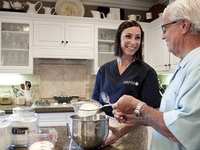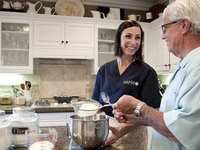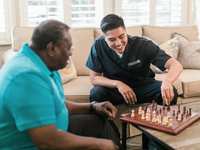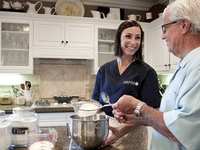- Categories :
- More
How Seniors Can Reduce Their Fall Risk and Recover Safely

Tis the season to talk about senior falls, which are one of the most serious health risks facing older adults. According to the CDC, one out of every four Americans age 65 and older experiences a fall each year. More than 37 million falls are reported annually—and sadly, they are the leading cause of injury-related deaths among seniors.
While these numbers may sound alarming, the good news is that most falls are preventable. By understanding the risks and taking proactive steps, seniors and their families can help ensure safety, independence, and confidence in daily living.
Why Falls Are So Dangerous for Seniors
As we age, our bones become more fragile, our balance and reflexes slow, and chronic health conditions can affect coordination. When a senior falls, the consequences can go far beyond bumps and bruises. Common injuries include:
- Hip fractures, which often require surgery and long recovery times
- Head injuries, including concussions and brain bleeds
- Broken wrists, arms, or ankles
- Emotional trauma, such as a lasting fear of falling again
This fear can lead many seniors to reduce their activity levels, which ironically weakens muscles and balance further—increasing the risk of another fall.
Common Risk Factors for Senior Falls
Some fall risks are environmental, while others are related to health or medication. The most common include:
- Poor balance or muscle weakness
- Vision problems
- Unsafe home environments (clutter, loose rugs, poor lighting)
- Side effects from medications, such as dizziness or drowsiness
- Chronic conditions like arthritis, diabetes, or neuropathy
- Improper footwear
Understanding these risks is the first step toward prevention.
How Seniors Can Reduce Their Risk of Falling
Here are some evidence-based ways to stay safe and steady:
1. Stay Active with Balance and Strength Exercises
Movement keeps your muscles, joints, and reflexes strong. Activities like tai chi, gentle yoga, or walking can greatly improve balance and stability. Many community centers and senior programs offer classes specifically for fall prevention.
Online resources include the “You Have the Power to Prevent a Fall” video from the National Council on Aging. CLICK HERE to view.
2. Have Regular Vision and Hearing Checks
Poor vision or hearing can make it harder to detect hazards. Make sure glasses prescriptions are up to date and hearing aids are functioning properly.
3. Review Medications with Your Doctor or Pharmacist
Some prescriptions and over-the-counter medicines can cause dizziness or low blood pressure. A medication review can help reduce side effects or identify better alternatives.
4. Make the Home Safer to Promote Senior Independence
Simple Home Modifications Can Drastically Reduce Senior Fall Risk:
- Remove loose rugs and clutter
- Install grab bars in the bathroom
- Add non-slip mats in the shower
- Improve lighting in hallways and stairs
- Use handrails on both sides of stairways
- Keep commonly used items within easy reach
Consider a home safety assessment from a professional caregiver service like Amada Senior Care to identify hidden hazards. An Amada senior advisor can help families identify funding solutions that can help cover the cost of home modifications, such as a Long-Term Care insurance policy.
CLICK HERE to learn about “Five Quick and Easy Home Modifications” from the National Council on Aging.
5. Wear Supportive Shoes
Avoid slippers, high heels, and shoes with slick soles. Opt for non-skid, supportive footwear that fits well.
6. Manage Chronic Health Conditions
Keep conditions like diabetes, heart disease, and arthritis under control with regular checkups. These conditions can affect balance, vision, and mobility if unmanaged.
What an Older Adult or Senior Can Do If a Fall Happens
Even with prevention, falls can occur. Knowing how to respond can make a major difference in recovery and long-term safety.
If You’re a Senior Who Has Fallen and Can’t Get Up:
- Stay calm and try to take slow breaths.
- Check for injuries before trying to move.
- Call for help using a phone, medical alert system, or by making noise to get attention.
- If you can, crawl to a sturdy piece of furniture and use it to help yourself up safely.
After a fall, always tell your doctor, even if you feel fine. Falls can cause hidden injuries or signal underlying issues like medication side effects, dehydration, or balance problems.
Tips for Seniors Recovering After a Fall
Recovery takes patience and support. Many seniors benefit from:
- Physical therapy to rebuild strength and balance
- Occupational therapy to learn safer ways to move at home
- Fall prevention programs, such as “Matter of Balance” classes offered by community centers or hospitals
- Emotional support to address fear and regain confidence
Family members can help by encouraging participation in safe exercise, maintaining a fall-free home environment, and arranging regular health checkups.
A Fall-Free Future for Aging Seniors
While falls are a leading cause of injury among older adults, they don’t have to be an inevitable part of aging. With the right precautions, awareness, and support, seniors can maintain their independence and live safely at home for years to come.
If you or a loved one has concerns about fall risks—or needs help creating a safer living environment—consider reaching out to a local home care agency like Amada Senior Care. Caregivers can provide mobility support, assist with home safety, and offer companionship to keep seniors active and confident.
If you or a senior loved would like to learn more about how home care can provide support after a hospital stay or a rehab center release, CLICK HERE to find your local Amada Senior Care office. We’re here to help.
















